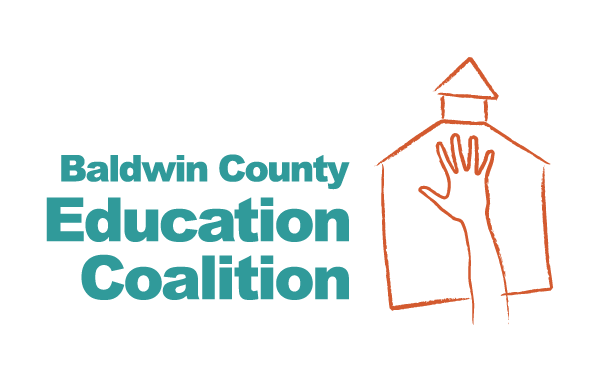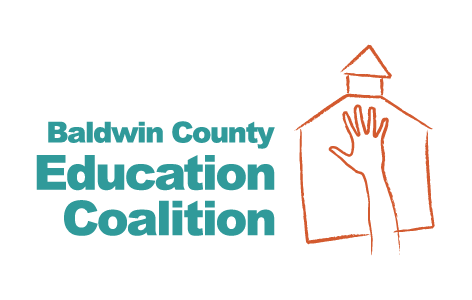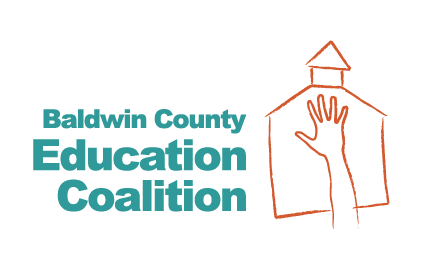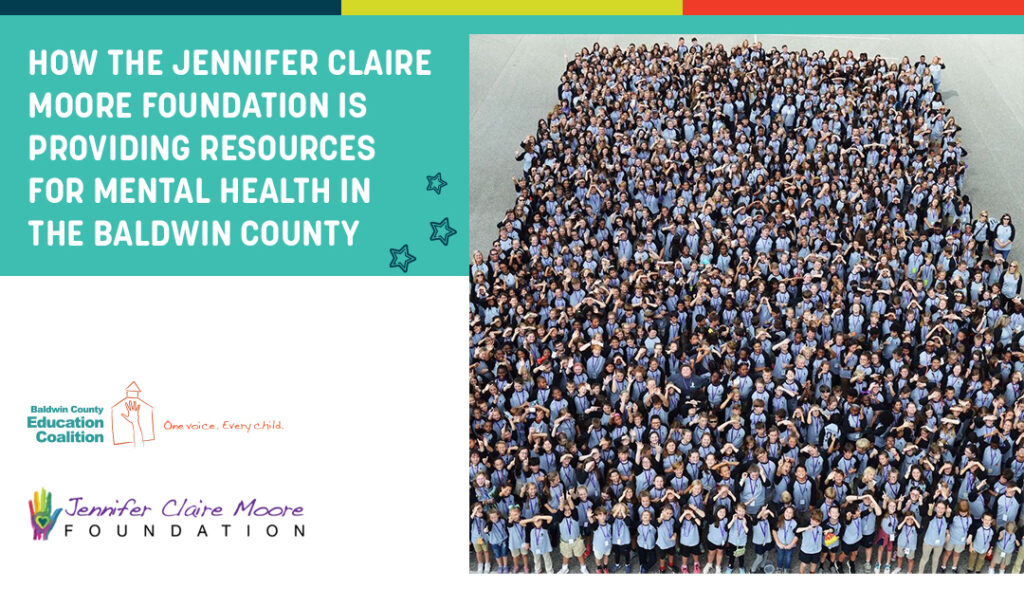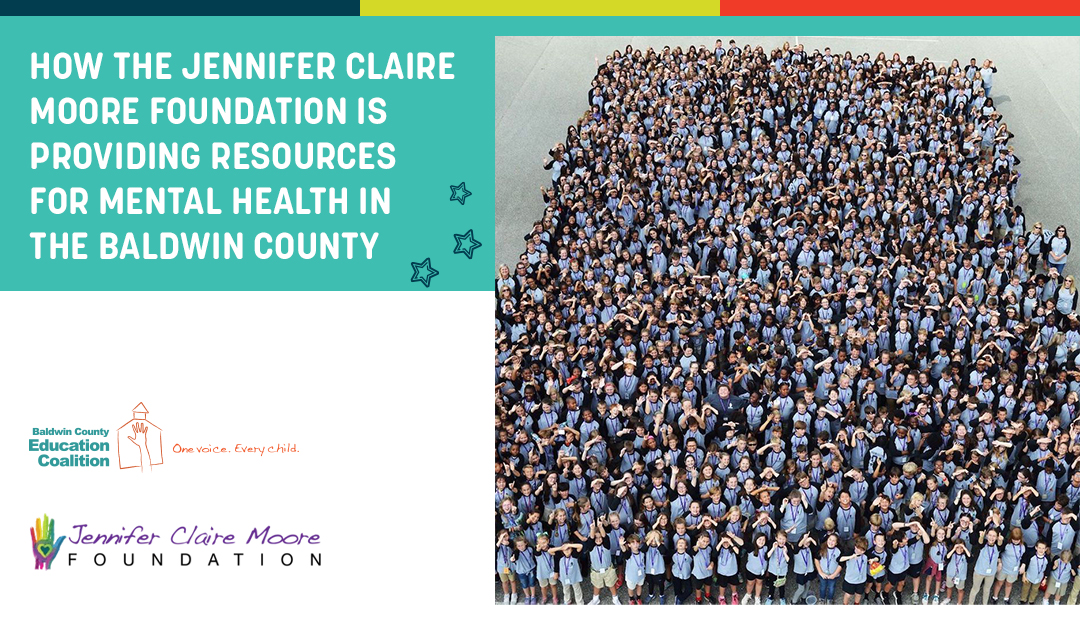
13 Sep How The Jennifer Claire Moore Foundation Is Providing Resources for Mental Health in the Baldwin County Community
September is Suicide Prevention Month. This month, and every month, it is important to us at the Coalition that we provide the resources our students need to access the guidance they deserve when it comes to their mental health. One of these resources is the Jennifer Claire Moore Foundation. Founded in 1998, the Jennifer Claire Moore Foundation works to provide the Baldwin County youth with the knowledge and confidence they need to successfully handle the pressures of their daily lives, and to help ensure that they succeed as they grow into adulthood. Read our blog to learn more about how the Jennifer Claire Moore Foundation is helping our students prosper and better understand their mental health and helping students receive the help they need when they are struggling.
The Jennifer Claire Moore Foundation was started in 1998 by the family of Jennifer Claire Moore following Jennifer’s suicide in 1997 when she was 16 years old. Jennifer’s mother Frances Holk Moore is the Co-Founder and Chairman of the Foundation, and Jennifer’s brother Grayson Moore is the President. The Coalition sat down with Allison Moore, wife to Grayson and Executive Director of the foundation, to discuss how the foundation is working to prevent any families from suffering the loss that the Moore’s endured when Jennifer died, and to create a support group for students in Baldwin County to help students cope with the pressures they are feeling at school and at home.
According to Moore, “96% of people who have an actual diagnosis for a mental health disorder do not have to seek regular treatment.” Moore says, “A diagnosis helps someone more easily access the help and guidance they need when dealing with their mental health.” For students and young people, however, mental health problems can often go undiagnosed, and the individual can be left struggling without the proper resources or human support that they need to get through the day. One of the main reasons Moore cites for young people not understanding how to address and handle their mental health is because mental health is traditionally not spoken about in a school setting. “We teach physical education from kindergarten all the way through school, but what about mental health,” Moore questions, “our whole goal is to help people understand the resources that are available to help talk about mental health and all that mental health encompasses.”
In 2021, Moore knows that we are working as a society to move further away from the stigma that has hung over the topic of mental health for years. And now, young people are far more digitally engrained than any other generation before them. Recent surveys show that 90% of 13–17-year-olds use social media, and on average teenagers are online almost nine hours a day. While exposure to social media and usage of the internet via phones or computers is not all damaging, a lot of it used for school and homework, there are risks associated with the growing amount of time middle school and high school aged students are spending online. These risks include but are not limited to, exposure to harmful or inappropriate content (i.e., sex, drugs and violence), exposure to dangerous people, cyber bullying, oversharing their personal information, exposure to excessive advertisements, and interference with their sleep, exercise, homework and time with family and friends. As a teenager, it can be hard to navigate the feelings of anxiety, isolation and hopelessness that stems from consuming large quantities of social media content.
In addition to some of the more negative effects of screen time for teenagers, the COVID-19 pandemic presented additional challenges for students who may have already been struggling. As Moore says, “The pandemic is something we didn’t know how to prepare for, how long it would last or what the impact would be. Every child was in a separate boat, and how one handled it does not mean that another handled it the same way.” The pandemic put additional stress on school-aged children, as they took on the stress felt by their family members or guardians. “There are situations that played a role in how the children reacted to the pandemic. Were they the ones more subjectable to COVID-19? Did they lose a family member? Every child had a different experience, and this can be very isolating for students struggling with mental health,” says Moore.
As Baldwin County schools have re-opened for the 2021-22 school year, Moore is hopeful that students resuming in the classroom in the safest way possible will be healthy for students as they start to reconnect to one another and retain a sense of normalcy. “Children are very resilient, and they adapt with the rules very quickly. I think the hardship in the mental health realm is that we have to adapt to ever-changing rules, and the rules change as we adapt to the storms that come our way.” Moore cautions parents and educators as school resumes and the COVID-19 pandemic continues, to not put the stress of the pandemic on the shoulders of our students. Moore says, “Sometimes we put our anxieties and our worries on our children or students. If we are clear and transparent with our students, they can remain resilient and adapt to the new rules. Socialization, coming together as a community, and being physically around someone else is how we were designed. Human connection is very important.”
So, where can we go from here? How do we step in and help struggling students combat to compounded pressures of ever-evolving social media platforms and the pandemic? The Jennifer Claire Moore Foundation gives our community access to the helpful resources we need as parents, educators and allies of Baldwin County students that give us the tools we need to understand and deal with mental health in the right ways. On their website, the foundation has parents and student resources for grades K-12, with guidance on topics that range from bullying and abuse to substance abuse and a general understanding on all the factors at play when we talk about mental health. Additionally, the foundation offers training for Youth Mental Health First Aid that offers courses that can help to educate the community on common mental health challenges and further guidance on topics such as disruptive behavioral disorder and depression in teens.
On top of the online resources available on the foundation’s website, there is also the Peer Helpers program which works to match kindergarten through 12th grade students who have the skills to support their at-risk classmates. This goes back to what Moore said about how crucial socialization and human connectivity is for our mental health and recognizes that young people who are experiencing any sort of crisis are more likely to trust a peer than they are an adult. Because of this, the Peer Helpers program works to connect students to one another, and work to combat the stigma about mental health within schools. The program helps to foster empathy between peers and encourages students to reach out to and try to connect with members of their school who may be having a hard time. “It is important for our students to know that the way we treat others and ourselves is all a part of our mental health,” says Moore.
Over the past few years, the Coalition has been delighted to sponsor educators to attend the foundation’s National Peer Program Conference, which is a two-day training program with the goal of certifying educators in Youth Mental Health First Aid. The conference helps attendees understand the ins-and-outs of youth mental health, including equipping them with a 5-step action plan they can use to help young people in both crisis and non-crisis situations. The next will be November 11-12 at Perdido Beach Resort in Orange Beach.
At the end of the day, no matter how we go about it, the Jennifer Claire Moore Foundation wants to help make mental health something we address and discuss in our schools and with our children at home. “I would share with someone who may be concerned about a student or a young individual, that, first, we need to assess and get support, but also that we need to work to access the resources available for understanding what that young person is going through,” says Moore. The foundation wants to make sure that the community understands mental health, and that people feel empowered and equipped to help our students whenever they are struggling. “We want to provide practical things that they can take back home and use in their daily lives. Resources are specifically designed for parents and students of all ages, and it is just as important that we educate the students on their own mental health.” As a community, we can work to make the mental health of our students a priority.
For more information on the resources provided by the Jennifer Claire Moore Foundation, visit their website at: https://jennifermoorefoundation.com/ For information on the Peer Helpers program visit: https://jennifermoorefoundation.com/pages/peerhelpers-program If you are a parent or educator interested in attending this year’s National Peer Program Conference, you can find more information here: https://jennifermoorefoundation.com/collections/conference-registration If you feel called to donate and help the work of the foundation please find more information here: https://jennifermoorefoundation.com/collections/conference-registration#
We hope that struggling young people can find the help that they need when it comes to their mental health, however if you or someone you know is in a crisis situation, please use the following resources:
- The National Suicide Prevention Lifeline: 1-800-273-TALK (8255)
- Spanish Lifeline: 1-888-628-9454
- Crisis Text Line: Text “HELLO” to 741-741
